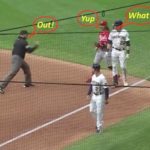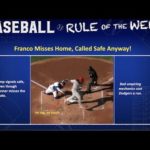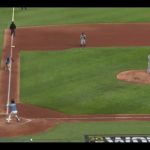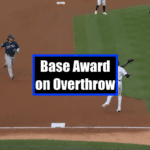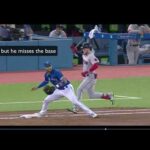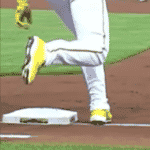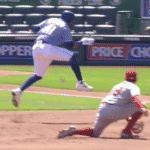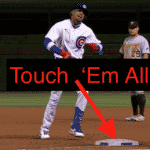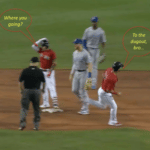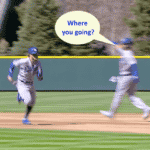5.09 Making an Out
(a) Retiring the Batter
A batter is out when:
(1) His fair or foul fly ball (other than a foul tip) is legally caught by a fielder;
Rule 5.09(a)(1) Comment: A fielder may reach into, but not step into, a dugout to make a catch, and if he holds the ball, the catch shall be allowed. A fielder, in order to make a catch on a foul ball nearing a dugout or other out-of-play area (such as the stands), must have one or both feet on or over the playing surface (including the lip of the dugout) and neither foot on the ground inside the dugout or in any other out-of-play area. Ball is in play, unless the fielder, after making a legal catch, steps or falls into a dugout or other out-of-play area, in which case the ball is dead. Status of runners shall be as described in Rule 5.06(b)(3)(C) Comment.
A catch is the act of a fielder in getting secure possession in his hand or glove of a ball in flight and firmly holding it; providing he does not use his cap, protector, pocket or any other part of his uniform in getting possession. It is not a catch, however, if simultaneously or immediately following his contact with the ball, he collides with a player, or with a wall, or if he falls down, and as a result of such collision or falling, drops the ball. It is not a catch if a fielder touches a fly ball which then hits a member of the offensive team or an umpire and then is caught by another defensive player. In establishing the validity of the catch, the fielder shall hold the ball long enough to prove that he has complete control of the ball and that his release of the ball is voluntary and intentional. If the fielder has made the catch and drops the ball while in the act of making a throw following the catch, the ball shall be adjudged to have been caught.
Catch Comment: A catch is legal if the ball is finally held by any fielder, even though juggled, or held by another fielder before it touches the ground. Runners may leave their bases the instant the first fielder touches the ball. A fielder may reach over a fence, railing, rope or other line of demarcation to make a catch. He may jump on top of a railing, or canvas that may be in foul ground. No interference should be allowed when a fielder reaches over a fence, railing, rope or into a stand to catch a ball. He does so at his own risk.
If a fielder, attempting a catch at the edge of the dugout, is “held up” and kept from an apparent fall by a player or players of either team and the catch is made, it shall be allowed.
(2) A third strike is legally caught by the catcher;
Rule 5.09 (a )(2) Comment: “Legally caught” means in the catcher’s glove before the ball touches the ground. It is not legal if the ball lodges in his clothing or paraphernalia; or if it touches the umpire and is caught by the catcher on the rebound.
If a foul tip first strikes the catcher’s glove and then goes on through and is caught by both hands against his body or protector, before the ball touches the ground, it is a strike, and if third strike, batter is out. If smothered against his body or protector, it is a catch provided the ball struck the catcher’s glove or hand first.
(3) A third strike is not caught by the catcher when first base is occupied before two are out;
(4) He bunts foul on third strike;
(5) An Infield Fly is declared;
(6) He attempts to hit a third strike and the ball touches him;
(7) His fair ball touches him before touching a fielder. If the batter is in a legal position in the batter’s box, see Rule 5.04(b)(5), and, in the umpire’s judgment, there was no intention to interfere with the course of the ball, a batted ball that strikes the batter or his bat shall be ruled a foul ball;
(8) After hitting or bunting a fair ball, his bat hits the ball a second time in fair territory. The ball is dead and no runners may advance. If the batter-runner drops his bat and the ball rolls against the bat in fair territory and, in the umpire’s judgment, there was no intention to interfere with the course of the ball, the ball is alive and in play. If the batter is in a legal position in the batter’s box, see Rule 5.04(b)(5), and, in the umpire’s judgment, there was no intention to interfere with the course of the ball, a batted ball that strikes the batter or his bat shall be ruled a foul ball;
Rule 5.09(a)(8) Comment: If a bat breaks and part of it is in fair territory and is hit by a batted ball or part of it hits a runner or fielder, play shall continue and no interference called. If a batted ball hits part of a broken bat in foul territory, it is a foul ball.
If a whole bat is thrown into fair or foul territory and interferes with a defensive player attempting to make a play, interference shall be called, whether intentional or not.
In cases where the batting helmet is accidentally hit with a batted ball on or over fair territory or a thrown ball, the ball remains in play the same as if it has not hit the helmet.
If a batted ball strikes a batting helmet or any other object foreign to the natural ground while on foul territory, it is a foul ball and the ball is dead.
If, in the umpire’s judgment, there is intent on the part of a baserunner to interfere with a batted or thrown ball by dropping the helmet or throwing it at the ball, then the runner would be out, the ball dead and runners would return to last base legally touched.
(9) After hitting or bunting a ball that continues to move over foul territory, he intentionally deflects the course of the ball in any manner while running to first base. The ball is dead and no runners may advance;
(10) After a third strike or after he hits a fair ball, he or first base is tagged before he touches first base;
(11) In running the last half of the distance from home base to first base, while the ball is being fielded to first base, he runs outside (to the right of ) the three-foot line, or inside (to the left of ) the foul line, and in the umpire’s judgment in so doing interferes with the fielder taking the throw at first base, in which case the ball is dead; except that he may run outside (to the right of ) the three-foot line or inside (to the left of ) the foul line to avoid a fielder attempting to field a batted ball;
Rule 5.09(a)(11) Comment: The lines marking the three-foot lane are a part of that lane and a batter-runner is required to have both feet within the three-foot lane or on the lines marking the lane. The batter-runner is permitted to exit the threefoot lane by means of a step, stride, reach or slide in the immediate vicinity of first base for the sole purpose of touching first base.
(12) An infielder intentionally drops a fair fly ball or line drive, with first, first and second, first and third, or first, second and third base occupied before two are out. The ball is dead and runner or runners shall return to their original base or bases;
APPROVED RULING: In this situation, the batter is not out if the infielder permits the ball to drop untouched to the ground, except when the Infield Fly rule applies.
(13) A preceding runner shall, in the umpire’s judgment, intentionally interfere with a fielder who is attempting to catch a thrown ball or to throw a ball in an attempt to complete any play;
Rule 5.09(a)(13) Comment: The objective of this rule is to penalize the offensive team for deliberate, unwarranted, un-sportsmanlike action by the runner in leaving the baseline for the obvious purpose of crashing the pivot man on a double play, rather than trying to reach the base. Obviously this is an umpire’s judgment play. (See Rule 6.01(j).)
(14) With two out, a runner on third base, and two strikes on the batter, the runner attempts to steal home base on a legal pitch and the ball touches the runner in the batter’s strike zone. The umpire shall call “Strike Three,” the batter is out and the run shall not count; before two are out, the umpire shall call “Strike Three,” the ball is dead, and the run counts;
(15) A member of his team (other than a runner) hinders a fielder’s attempt to catch or field a batted ball. See Rule 6.01(b). For interference by a runner, see Rule 5.09(b)(3).
(b) Retiring a Runner
Any runner is out when:
(1) He runs more than three feet away from his base path to avoid being tagged unless his action is to avoid interference with a fielder fielding a batted ball. A runner’s base path is established when the tag attempt occurs and is a straight line from the runner to the base he is attempting to reach safely; or
(2) After touching first base, he leaves the base path, obviously abandoning his effort to touch the next base;
Rule 5.09(b)(1) and (2) Comment: Any runner after reaching first base who leaves the base path heading for his dugout or his position believing that there is no further play, may be declared out if the umpire judges the act of the runner to be considered abandoning his efforts to run the bases. Even though an out is called, the ball remains in play in regard to any other runner.
This rule also covers the following and similar plays: Less than two out, score tied last of ninth inning, runner on first, batter hits a ball out of park for winning run, the runner on first passes second and thinking the home run automatically wins the game, cuts across diamond toward his bench as batter-runner circles bases. In this case, the base runner would be called out “for abandoning his effort to touch the next base” and batter-runner permitted to continue around bases to make his home run valid. If there are two out, home run would not count. See Rule 5.09(d). This is not an appeal play.
PLAY—Runner believing he is called out on a tag at first or third base starts for the dugout and progresses a reasonable distance still indicating by his actions that he is out, shall be declared out for abandoning the bases.
(3) He intentionally interferes with a thrown ball; or hinders a fielder attempting to make a play on a batted ball (see Rule 6.01(j));
PENALTY: For penalties applying to a runner’s intentional interference with a thrown ball or his hindrance of a fielder’s attempt to make a play on a batted ball, see Rule 6.01(a) PENALTY FOR INTERFERENCE Comment.
(4) He is tagged, when the ball is alive, while off his base.
EXCEPTION: A batter-runner cannot be tagged out after overrunning or oversliding first base if he returns immediately to the base;
APPROVED RULING: (A) If the impact of a runner breaks a base loose from its position, no play can be made on that runner at that base if he had reached the base safely.
APPROVED RULING: (B) If a base is dislodged from its position during a play, any following runner on the same play shall be considered as touching or occupying the base if, in the umpire’s judgment, he touches or occupies the point marked by the dislodged bag.
(5) He fails to retouch his base after a fair or foul ball is legally caught before he, or his base, is tagged by a fielder. He shall not be called out for failure to retouch his base after the first following pitch, or any play or attempted play. This is an appeal play;
Rule 5.09(b)(5) Comment: Runners need not “tag up” on a foul tip. They may steal on a foul tip. If a so-called tip is not caught, it becomes an ordinary foul. Runners then return to their bases.
(6) He or the next base is tagged before he touches the next base, after he has been forced to advance by reason of the batter becoming a runner. However, if a following runner is put out on a force play, the force is removed and the runner must be tagged to be put out. The force is removed as soon as the runner touches the base to which he is forced to advance, and if he overslides or overruns the base, the runner must be tagged to be put out. However, if the forced runner, after touching the next base, retreats for any reason towards the base he had last occupied, the force play is reinstated, and he can again be put out if the defense tags the base to which he is forced;
Rule 5.09(b)(6) Comment:
PLAY—Runner on first and three balls on batter: Runner steals on the next pitch, which is fourth ball, but after having touched second he overslides or overruns that base. Catcher’s throw catches him before he can return.
Ruling is that runner is out. (Force out is removed.) Oversliding and overrunning situations arise at bases other than first base. For instance, before two are out, and runners on first and second, or first, second and third, the ball is hit to an infielder who tries for the double play. The runner on first beats the throw to second base but overslides the base. The relay is made to first base and the batter-runner is out. The first baseman, seeing the runner at second base off the bag, makes the return throw to second and the runner is tagged off the base. Meanwhile runners have crossed the plate. The question is: Is this a force play? Was the force removed when the batter-runner was out at first base? Do the runs that crossed the plate during this play and before the third out was made when the runner was tagged at second, count? Answer: The runs score. It is not a force play. It is a tag play.
(7) He is touched by a fair ball in fair territory before the ball has gone through, or by, an infielder and no other infielder has a chance to make a play on the ball. The ball is dead and no runner may score, nor runners advance, except runners forced to advance. EXCEPTION: If a runner is touching his base when touched by an Infield Fly, he is not out, although the batter is out;
Rule 5.09(b)(7) Comment: If two runners are touched by the same fair ball, only the first one is out because the ball is instantly dead. If a runner is touched by an Infield Fly when he is not touching his base, and before the ball has gone through, or by, an infielder, and no other infielder has a chance to make a play on the ball, both the runner and batter are out. Regardless of whether a runner is touching his base or not when touched by an Infield Fly before the ball has gone through, or by, an infielder and no other infielder has a chance to make a play on the ball, the ball is dead and no runner may score, nor runners advance, except runners forced to advance.
(8) He attempts to score on a play in which the batter interferes with the play at home base before two are out. With two out, the interference puts the batter out and no score counts;
(9) He passes a preceding runner before such runner is out;
Rule 5.09(b)(9) Comment: A runner may be deemed to have passed a preceding (i.e., lead) runner based on his actions or the actions of a preceding runner.
PLAY—Runners on second base and third base with one out. The runner from third base (i.e., the lead runner) makes an advance toward home and is caught in a rundown between third base and home plate. Believing the lead runner will be tagged out, the runner at second base (i.e., the trailing runner) advances to third base. Before being tagged, the lead runner runs back to and beyond third base toward left field. At this time, the trailing runner has passed the lead runner as a result of the lead runner’s actions. As a result, the trailing runner is out and third base is unoccupied. The lead runner is entitled to third base if he returns to touch it before he is out, see Rule 5.06(a)(1), unless he is declared out for abandoning the bases.
(10) After he has acquired legal possession of a base, he runs the bases in reverse order for the purpose of confusing the defense or making a travesty of the game. The umpire shall immediately call “Time” and declare the runner out;
Rule 5.09(b)(10) Comment: If a runner touches an unoccupied base and then thinks the ball was caught or is decoyed into returning to the base he last touched, he may be put out running back to that base, but if he reaches the previously occupied base safely he cannot be put out while in contact with that base.
(11) He fails to return at once to first base after overrunning or oversliding that base. If he attempts to run to second he is out when tagged. If, after overrunning or oversliding first base he starts toward the dugout, or toward his position, and fails to return to first base at once, he is out, on appeal, when he or the base is tagged;
Rule 5.09(b)(11) Comment: Runner who touches first base in overrunning and is declared safe by the umpire has, within the intent of Rule 5.08(a) “reached first base” and any run which scores on such a play counts, even though the runner subsequently becomes the third out for failure to return “at once,” as covered in Rule 5.09(b)(11).
(12) In running or sliding for home base, he fails to touch home base and makes no attempt to return to the base, when a fielder holds the ball in his hand, while touching home base, and appeals to the umpire for the decision;
Rule 5.09(b)(12) Comment: This rule applies only where runner is on his way to the bench and the catcher would be required to chase him. It does not apply to the ordinary play where the runner misses the plate and then immediately makes an effort to touch the plate before being tagged. In that case, runner must be tagged.
(13) A play on him is being made and a member of his team (other than a runner) hinders a fielder’s attempt to field a thrown ball. See Rule 5.09(b)(3). For interference by a runner, see Rule 5.09(b)(3).
(c) Appeal Plays
Any runner shall be called out, on appeal, when:
(1) After a fly ball is caught, he fails to retouch his original base before he or his original base is tagged;
Rule 5.09(c)(1) Comment: “Retouch,” in this rule, means to tag up and start from a contact with the base after the ball is caught. A runner is not permitted to take a flying start from a position in back of his base. Such runner shall be called out on appeal.
(2) With the ball in play, while advancing or returning to a base, he fails to touch each base in order before he, or a missed base, is tagged;
APPROVED RULING: (A) No runner may return to touch a missed base after a following runner has scored. (B) When the ball is dead, no runner may return to touch a missed base or one he has left after he has advanced to and touched a base beyond the missed base.
Rule 5.09(c)(2) Comment:
PLAY—(A) Batter hits ball out of park or ground rule double and misses first base (ball is dead)—he may return to first base to correct his mistake before he touches second but if he touches second he may not return to first and if defensive team appeals he is declared out at first.
PLAY—(B) Batter hits ball to shortstop who throws wild into stand (ball is dead)—batter-runner misses first base but is awarded second base on the overthrow. Even though the umpire has awarded the runner second base on the overthrow, the runner must touch first base before he proceeds to second base.
These are appeal plays.
(3) He overruns or overslides first base and fails to return to the base immediately, and he or the base is tagged prior to the runner returning to first base;
(4) He fails to touch home base and makes no attempt to return to that base, and home base is tagged.
Any appeal under this rule must be made before the next pitch, or any play or attempted play. If the violation occurs during a play which ends a half-inning, the appeal must be made before the defensive team leaves the field.
An appeal is not to be interpreted as a play or an attempted play.
Successive appeals may not be made on a runner at the same base. If the defensive team on its first appeal errs, a request for a second appeal on the same runner at the same base shall not be allowed by the umpire. (Intended meaning of the word “err” is that the defensive team in making an appeal threw the ball out of play. For example, if the pitcher threw to first base to appeal and threw the ball into the stands, no second appeal would be allowed.)
Appeal plays may require an umpire to recognize an apparent “fourth out.” If the third out is made during a play in which an appeal play is sustained on another runner, the appeal play decision takes precedence in determining the out. If there is more than one appeal during a play that ends a half-inning, the defense may elect to take the out that gives it the advantage. For the purpose of this rule, the defensive team has “left the field” when the pitcher and all infielders have left fair territory on their way to the bench or Clubhouse.
Rule 5.09(c) Comment: If two runners arrive at home base about the same time and the first runner misses home plate but a second runner legally touches the plate, the runner is tagged out on his attempt to come back and touch the base or is called out, on appeal, then he shall be considered as having been put out before the second runner scored and being the third out. Second runner’s run shall not count, as provided in Rule 5.09(d).
If a pitcher balks when making an appeal, such act shall be a play. An appeal should be clearly intended as an appeal, either by a verbal request by the player or an act that unmistakably indicates an appeal to the umpire. A player, inadvertently stepping on the base with a ball in his hand, would not constitute an appeal. Time is not out when an appeal is being made.
(d) Effect of Preceding Runner’s Failure to Touch a Base
Unless two are out, the status of a following runner is not affected by a preceding runner’s failure to touch or retouch a base. If, upon appeal, the preceding runner is the third out, no runners following him shall score. If such third out is the result of a force play, neither preceding nor following runners shall score.
(e) Retiring the Side
When three offensive players are legally put out, that team takes the field and the opposing team becomes the offensive team.





